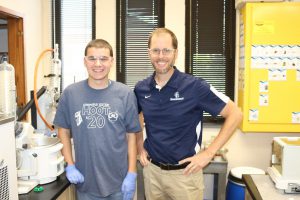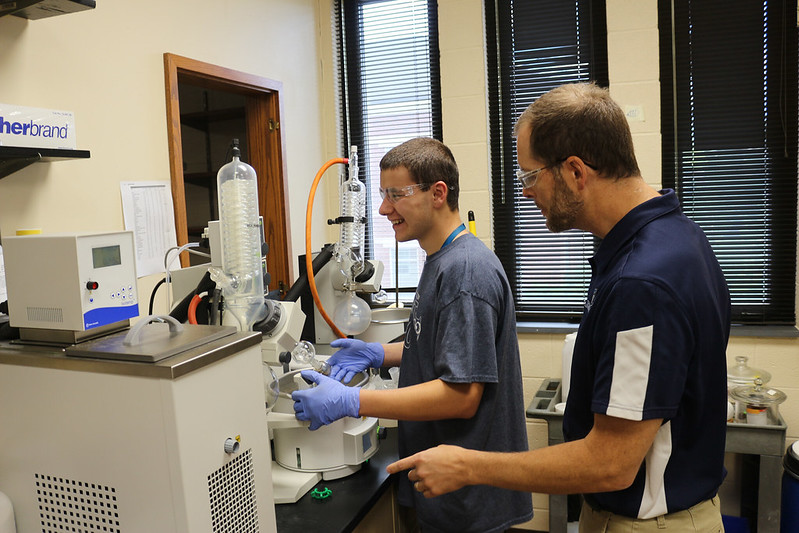An Elizabethtown College Biochemistry and Molecular Biology student is continuing the research he started last semester working one-on-one with a Chemistry professor this summer to improve the synthesis of M, a 2-aminopyridine derived nuclease that could likely have therapeutic applications.
The independent student research and collaboration with an Etown faculty mentor, is part of the Summer Scholarship, Creative Arts and Research Projects (SCARP) program.
Title of Research
Optimization and Scale-up of a 2-aminopyridine derived Peptide Nucleic Acid Monomer
Student Researcher
Tristan Mabee ‘24 – Biochemistry and Molecular Biology major
Faculty Mentor
James MacKay, Professor of Chemistry
What are you researching?
Tristan: RNA is a biological molecule with many varied roles and important biological functions, including transcription, gene inhibition, and function as a catalyst. Given these functions (including undiscovered ones), RNA recognition is an attractive goal. Non-coding RNA generally exists as a double strand in a form similar to DNA. Research from collaborators at Binghamton University has shown that Peptide Nucleic Acids bind to RNA at physiologically relevant conditions. One of the most impactful innovations has been the use of “m,” a 2-aminopyridine derived nucleobase that recognizes the C-G base pair in dsRNA. Unfortunately, the production of M is slow, low-yielding, and requires challenging purification steps. Our work looks to improve this synthesis by fixing any one of the issues previously mentioned.
Why did you choose this topic?
Tristan: During the spring, I was working on improving the synthesis of this reaction, so it felt natural to continue this work into the summer. What really fascinates me about this molecule are the new doors opened by its high selectivity and affinity at physiological conditions. While therapeutic applications have been considered since early studies, “m” is one of the most likely candidates to be used in such applications. One of the few remaining obstacles though is difficulty in production. Fortunately, this is an obstacle that will be lessened through my work in SCARP.
What is the most interesting aspect of this research?
Tristan: My research has really increased my knowledge and love of RNA. It’s a biological molecule with a stunning number of purposes such as human biology, many of which are poorly studied. From blocking protein synthesis, to catalyzing reactions, to even modifying DNA, it certainly seems like a molecule that can do it all. Being able to work on a molecule that can serve as a detector for this natural wonder has been a fascinating experience.
How has Professor MacKay helped you throughout this experience?
Tristan: Dr. MacKay has served as an excellent mentor in two major ways. Lab work has been excellent under him as I’ve gained not only hands-on knowledge but a confidence that has greatly improved my ability to perform chemistry. Outside of the lab, my ability to articulate chemistry has also greatly improved under Dr. MacKay’s tutelage. Thanks to him, I’m far closer to not only being able to work as a chemist but also to communicate and report my work as such, which are two of the most important skills to have in this profession.
Hear from the Faculty Mentor – James MacKay
“Tristan has been a real treat to work with,” said MacKay. “I started him in the lab last spring as a first-year research student. He shows great enthusiasm for chemistry and has a real passion for learning new things. This summer he has learned new synthetic skills that are rarely performed by students as young as he. With many more years ahead, I expect to see some really great things.”

